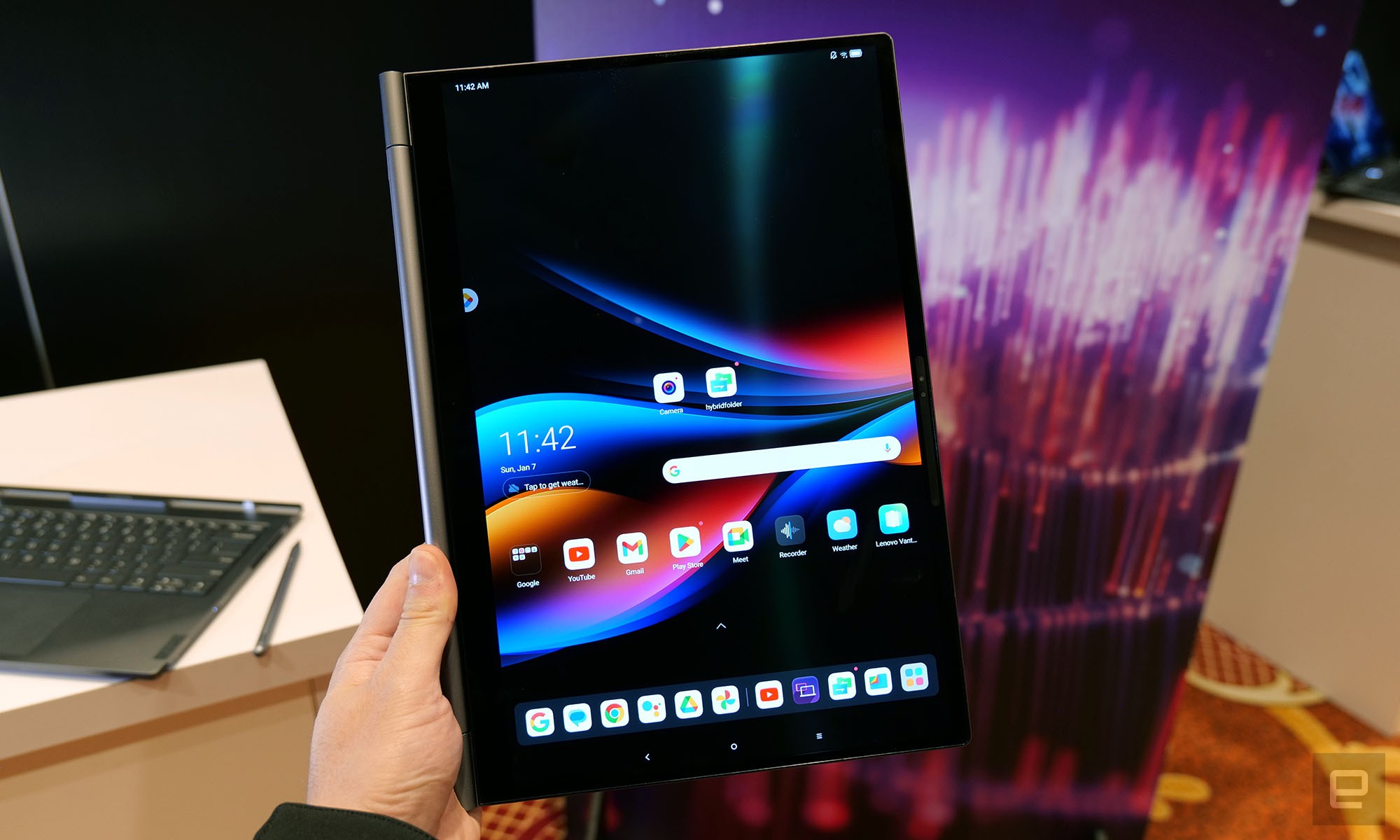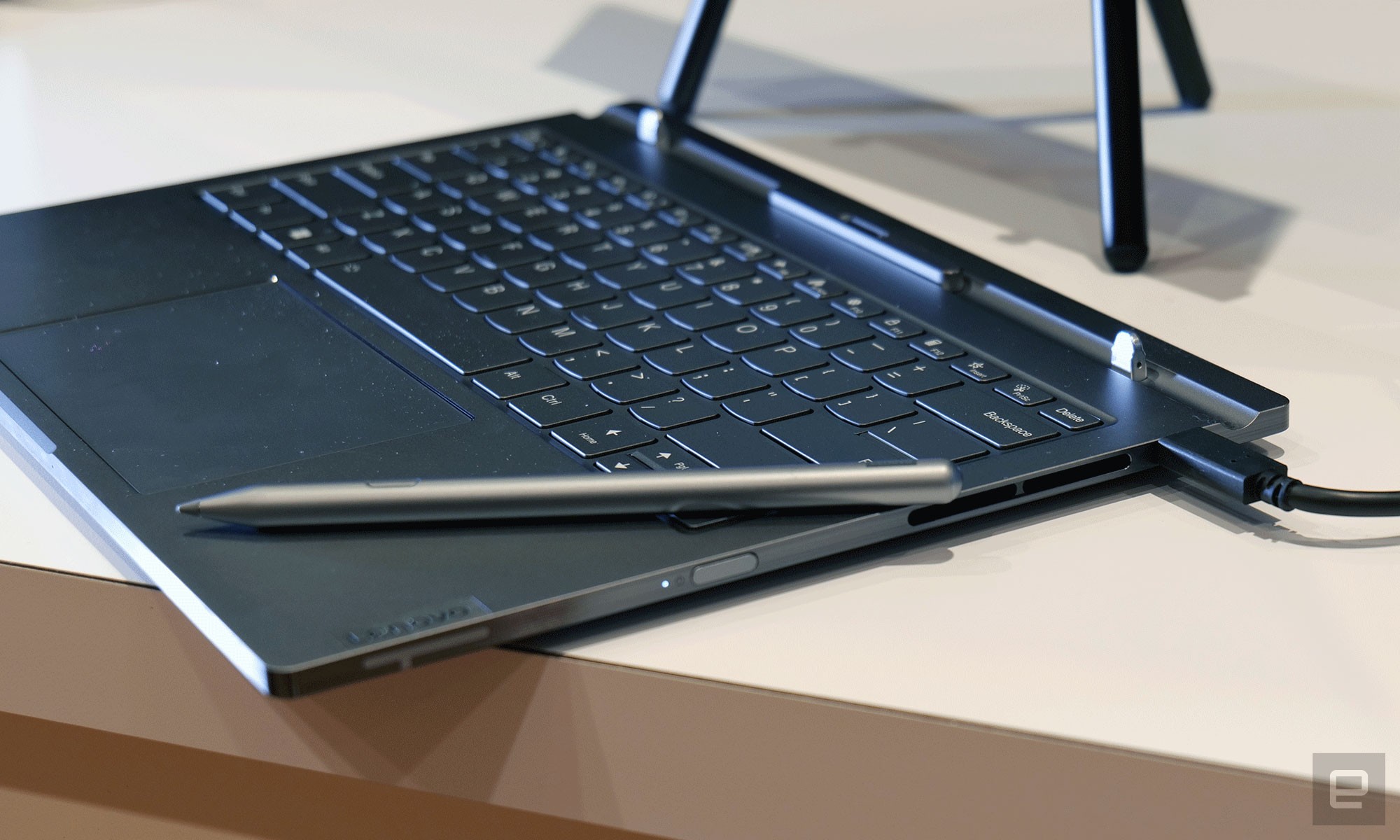- Регистрация
- 17 Февраль 2018
- Сообщения
- 29 367
- Лучшие ответы
- 0
- Баллы
- 2 093
Offline
Typically a 2-in-1 is something that can transform into multiple modes (e.g., a notebook that converts to tablet or vice versa). But with the ThinkBook Plus Gen 5 hybrid, Lenovo smashed two gadgets together to create one of the funkiest and most interesting laptops we've seen here at CES 2024 in Las Vegas.
At first glance, the ThinkBook Plus looks like an ordinary clamshell. However, if you pull up on the display, it lifts right off and becomes a 14-inch tablet while the bottom contains everything needed to power a traditional Windows PC (well, aside from a screen). From there, you can use the tablet as a standalone Android device, a wireless monitor for the laptop base, or a Wacom-like inking display via Lenovo’s Freestyle app. Meanwhile, you can use ThinkBook’s deck as a mini desktop just by plugging in an external screen.
The number of situations that might require having two separate devices running different OSes might be somewhat rare. However, this level of flexibility is rather unique. For example, if you’re browsing the web on the couch, you could just grab the tablet section and leave the bulky laptop chassis behind. Or you could give the tablet to a child while you work on the laptop. (Just be mindful of their total screen time, OK?) And to make sharing files across both devices as easy as possible, there’s a hybrid folder on both devices that syncs wirelessly. Just drag and drop and voila.

Photo by Sam Rutherford/Engadget
On top of that, the specs for both devices are pretty solid. The laptop is the beefier of the two packing an Intel Core Ultra 7 processor, up to 32GB of RAM, 1TB of SSD storage, Wi-Fi 6e and sizable 75Whr battery. The tablet on the other hand consists of a 14-inch 2.8K OLED screen with stylus input, Snapdragon 8+ Gen 1 chip, 12GB of RAM and a 38Whr battery. It also houses two rear cameras (13MP + 5MP) and a full HD IR selfie cam that the laptop can also use when the two are attached.
The somewhat surprising thing is that, for a pre-production device, everything functioned pretty smoothly. When I yanked off the display, the tablet instantly booted into Android. And when I placed it back on the laptop, it only took a second or two for the Windows desktop to reappear. The only software issue I ran into was when trying to use the tablet as a sketching aid. But that was more of a problem with the insane wireless congestion that you always battle during CES.

Photo by Sam Rutherford/Engadget
There were only two minor flaws that I noticed. The first is that, aside from a 3.5mm audio jack, there are only two USB-C ports. But since both are Thunderbolt 4, at least you’ll be getting excellent data speeds. The other is that the ThinkBook Plus’ keyboard is on the shallow side, so if you prefer a notebook with longer key travel, this might not be for you.
However, the ThinkBook Plus’ biggest hurdle may be its price. Because, starting at $1,999, Lenovo is charging a bit of a premium for the convenience of having two devices in one. That’s because unless you’re dead set on having a 14-inch tablet, it’s pretty easy to pick up a smaller Android slate plus a well-equipped ultraportable for way under $2,000.

Photo by Sam Rutherford/Engadget
But if this sort of frakengadget strikes your fancy, keep an eye out for it when it goes on sale sometime in Q2 2024.
We're reporting live from CES 2024 in Las Vegas from January 6-12. Keep up with all the latest news from the show here.
This article originally appeared on Engadget at https://www.engadget.com/the-lenovo...get-mashup-at-ces-2024-230059087.html?src=rss
At first glance, the ThinkBook Plus looks like an ordinary clamshell. However, if you pull up on the display, it lifts right off and becomes a 14-inch tablet while the bottom contains everything needed to power a traditional Windows PC (well, aside from a screen). From there, you can use the tablet as a standalone Android device, a wireless monitor for the laptop base, or a Wacom-like inking display via Lenovo’s Freestyle app. Meanwhile, you can use ThinkBook’s deck as a mini desktop just by plugging in an external screen.
The number of situations that might require having two separate devices running different OSes might be somewhat rare. However, this level of flexibility is rather unique. For example, if you’re browsing the web on the couch, you could just grab the tablet section and leave the bulky laptop chassis behind. Or you could give the tablet to a child while you work on the laptop. (Just be mindful of their total screen time, OK?) And to make sharing files across both devices as easy as possible, there’s a hybrid folder on both devices that syncs wirelessly. Just drag and drop and voila.
Photo by Sam Rutherford/Engadget
On top of that, the specs for both devices are pretty solid. The laptop is the beefier of the two packing an Intel Core Ultra 7 processor, up to 32GB of RAM, 1TB of SSD storage, Wi-Fi 6e and sizable 75Whr battery. The tablet on the other hand consists of a 14-inch 2.8K OLED screen with stylus input, Snapdragon 8+ Gen 1 chip, 12GB of RAM and a 38Whr battery. It also houses two rear cameras (13MP + 5MP) and a full HD IR selfie cam that the laptop can also use when the two are attached.
The somewhat surprising thing is that, for a pre-production device, everything functioned pretty smoothly. When I yanked off the display, the tablet instantly booted into Android. And when I placed it back on the laptop, it only took a second or two for the Windows desktop to reappear. The only software issue I ran into was when trying to use the tablet as a sketching aid. But that was more of a problem with the insane wireless congestion that you always battle during CES.
Photo by Sam Rutherford/Engadget
There were only two minor flaws that I noticed. The first is that, aside from a 3.5mm audio jack, there are only two USB-C ports. But since both are Thunderbolt 4, at least you’ll be getting excellent data speeds. The other is that the ThinkBook Plus’ keyboard is on the shallow side, so if you prefer a notebook with longer key travel, this might not be for you.
However, the ThinkBook Plus’ biggest hurdle may be its price. Because, starting at $1,999, Lenovo is charging a bit of a premium for the convenience of having two devices in one. That’s because unless you’re dead set on having a 14-inch tablet, it’s pretty easy to pick up a smaller Android slate plus a well-equipped ultraportable for way under $2,000.
Photo by Sam Rutherford/Engadget
But if this sort of frakengadget strikes your fancy, keep an eye out for it when it goes on sale sometime in Q2 2024.
We're reporting live from CES 2024 in Las Vegas from January 6-12. Keep up with all the latest news from the show here.
This article originally appeared on Engadget at https://www.engadget.com/the-lenovo...get-mashup-at-ces-2024-230059087.html?src=rss
